 Expert's opinion
Expert's opinion
Expert's opinion
The article is a subjective view on this topic written by writers specializing in medical writing.
It may reflect on a personal journey surrounding struggles with an illness or medical condition, involve product comparisons, diet considerations, or other health-related opinions.
Although the view is entirely that of the writer, it is based on academic experiences and scientific research they have conducted; it is fact-checked by a team of degreed medical experts, and validated by sources attached to the article.
The numbers in parenthesis (1,2,3) will take you to clickable links to related scientific papers.
Clean Eating Meal Plan For Beginners To Improve Your Diet 2024

“Clean eating” is a style of eating based on whole, unprocessed healthy foods, whilst avoiding processed foods high in refined fats and sugars. The goal is to focus on nutrient-dense foods, which help you achieve sustainable weight loss and optimal health.
This article is your ultimate guide to what a clean eating meal plan is, what to eat and avoid, and the benefits and risks of clean eating.
Clean Eating Meal Plan For Beginners
- Breakfast: Nutty Berry Yogurt Oat Bowl
- Lunch: Quinoa-bean Hearty Salad With Tahini Dressing
- Dinner: Salmon Delight With Steamed Tenderstem Broccoli And Nutty Brown Rice
- Snack: Fruit And Nut Delight
Sample Clean Eating Meal Plan
Here are our perfect clean-eating meal plans for beginners. It’s also a great clean-eating meal plan on a budget.
Breakfast: Nutty Berry Yogurt Oat Bowl (Approx. 406 Calories)
Start your day with a nutritious and satisfying breakfast that combines the creaminess of Greek yogurt with the sweet-tartness of mixed berries, the heartiness of oats, and the rich, nutty flavor of almond butter. Topped with chia seeds for an added boost of fiber and omega-3 fatty acids, this wholesome meal provides a perfect balance of flavors and textures to fuel your morning.
| Breakfast | |
| Greek (or soy) yogurt | One cup |
| Mixed frozen berries | One half cup |
| Oats | One quarter cup |
| Chia seeds | One tablespoon |
| Almond butter | One tablespoon |
Lunch: Quinoa-bean Hearty Salad With Tahini Dressing (Approx. 569 Calories)
Enjoy a nutrient-packed meal with this Quinoa-Bean Hearty Salad topped with a creamy Tahini Dressing. The combination of quinoa, white beans, fresh vegetables, and mixed seeds provides a satisfying mix of textures and flavors. The creamy tahini dressing adds a rich and savory dimension to this wholesome salad, making it a delightful and filling option for a balanced meal.
| Lunch | |
| Cooked quinoa | One half cup |
| Cooked white beans | One half cup |
| Avocado | One quarter |
| Mixed salad greens | One cup |
| Cherry tomatoes | Five |
| Bell pepper | One quarter |
| Mixed seeds (pumpkin, sunflower, sesame) | Two tablespoons |
| Tahini | One tablespoon |
| Lemon juice | One tablespoon |
| Soy milk | One tablespoon |
Dinner: Salmon Delight With Steamed Tenderstem Broccoli And Nutty Brown Rice (Approx. 549 Calories)
The salmon is oven-baked to perfection, ensuring a juicy and flaky texture. The steamed tenderstem broccoli adds a fresh and crunchy element to the dish, while the brown rice provides a wholesome source of fiber and energy. Drizzle the soy-ginger sauce over the salmon for an extra layer of savory and slightly sweet flavor that ties this meal together beautifully. It’s a well-balanced and satisfying dinner option.
| Dinner | |
| Baked salmon | Three oz |
| Tenderstem broccoli, steamed | One cup |
| Cooked brown rice | One half cup |
| Low-sodium soy sauce | One fifth tablespoon |
| Rice vinegar | One half tablespoon |
| Garlic minced | One glove |
| Grated fresh ginger | One teaspoon |
| Honey | One teaspoon |
Snacks (AM Or PM): Fruit And Nut Delight (Approx. 395 Calories)
Enjoy the perfect balance of sweetness and crunch with one to two pieces of these vibrant fruits. Accompanying this fruity ensemble is a quarter cup of mixed nuts, providing a satisfying blend of textures and a boost of healthy fats and protein. To satisfy your sweet tooth, savor the richness of two squares of dark chocolate. This thoughtfully curated snack not only tantalizes your taste buds but also offers a wholesome combination of flavors and nutrients for a satisfying and energizing break.
| Snack | |
| Fresh fruits (e.g., apple, banana, pear) | One-two pieces |
| Mixed nuts | One quarter cup |
| Dark chocolate | Two squares |
What Is A Clean-Eating Meal Plan?
Clean eating aims to focus on the most nutrient-dense foods which are best for your overall health and well-being. A clean eating meal plan includes lots of healthy whole foods, such as beans, lentils, nuts, seeds, whole grains, fruits, and vegetables, and is usually predominantly plant-based.
Clean eating also encourages eating less refined and processed foods. Studies show that those who adhere to clean eating dietary advice are more likely to meet the recommended intakes[1] for healthy foods, such as fruits, and unhealthy foods, such as meat and meat alternatives.
Does This Mean Some Foods Are “Dirty”?
“Clean eating” makes it sound like some foods are “dirty.” Many processed foods contain additives, preservatives, and other chemicals that are harmful to human health. Some are even known carcinogens.
Clean eating naturally helps you avoid these harmful ingredients by eliminating processed foods. The Environmental Working Group (EWG)[2] also lists these harmful additives[3] on its website.
Can I Eat Meat?
Plant-based foods have extra health benefits as they’re rich in antioxidants, such as polyphenols and flavonoids. These can protect against chronic disease and even extend lifespan[4].
However, if including animal foods, focus on lean proteins such as chicken, fish, and eggs. Avoid red meat as it tends to be high in saturated fat.
Saturated fat should be limited in the diet as it leads to the formation of unwanted cholesterol in the form of low-density lipoproteins (LDL) or bad cholesterol.
Can I Drink Coffee?
Some clean eating meal plans may encourage you to cut down on caffeine. Drinking too much coffee or tea can “cover up” mid-afternoon energy slumps, which are actually caused by poor dietary choices or not getting enough quality sleep[5].
By sticking to a maximum of 1-2 cups of coffee or tea daily before noon, you may focus more on eating foods that keep your energy levels stable and get good-quality sleep, rather than relying on caffeine.
Should I Eat Organic?
Pesticide exposure may be linked to health issues[6]. For instance, some scientists think gluten intolerance might in fact be a pesticide intolerance[7].
However, you don’t have to eat everything organic. The EWG[2] regularly updates a list of foods highest in pesticides, called the “Dirty Dozen[8].”
If you’re worried about pesticide exposure, consider buying some of these foods organic or washing them before consumption in order to remove pesticide residues[9].
Benefits Of A Clean Eating Diet
Clean Eating Plan For Weight Loss
A clean eating meal plan can help you lose weight naturally because it includes lots of foods rich in protein, fiber, and healthy fats, which fill you up for longer than refined and processed foods can.
For example, eating eggs for breakfast leads to eating fewer calories at lunchtime[10], compared to eating toast or breakfast cereal.
Unsurprisingly, studies show that a predominantly whole-food plant-based naturally leads to less body fat and sustainable weight loss over time[11].
Better Gut Health
Eating more fiber from a range of plant-based whole foods improves overall gut function[12] and increases the diversity of the gut microbiome[13] and the production of health-promoting metabolites[14], such as short-chain fatty acids.
Your gut microbiome is made up of numerous bacteria whose main function is to support your health and well-being.
Lower Risk Of Type 2 Diabetes
Refined carbohydrates, processed and red meat[15] increase the risk of type 2 diabetes. Conversely, whole-food carbohydrates are linked to better blood sugar balance.
Eat at least two servings per day of whole grains[16] to reduce your risk of type 2 diabetes. One easy swap is brown instead of white rice (although some prefer to use cauliflower rice instead).
Lower Risk Of Cardiovascular Disease
Plant-based foods contain low amounts of saturated fat, one of the main risk factors for cardiovascular disease[17].
Studies show that eating plant-based can lower “bad” cholesterol levels[18] (LDL-C) and protect heart health.
Improved Energy Levels
Studies show that eating less-processed whole grains over two weeks helps prevent dips in blood sugar[19], which can avoid that post-lunch afternoon energy slump and lead to more stable energy levels.
Better Immune Function
Getting sick all the time? You need lots of nutrients to keep your immune system functioning properly. The problem is that most nutrients are stripped out of processed foods.
For example, most of the nutrients in wheat is concentrated in the wheat germ[20], which is stripped away to make white flour and products made with refined grains.
Conversely, a diet rich in whole plant-based foods can improve immune function by reducing inflammation due to antioxidant plant polyphenols[21] and healthy fats[22].
Better Skin Health
Avoiding processed foods means less plastic, too. Plastic food packaging contains a harmful chemical additive called bisphenol-A (BPA).
BPA is a known “endocrine-disruptor,”[23] meaning that it can disrupt hormone levels. Studies show that people with acne have higher levels of BPA[24] in their blood.
Risks
There aren’t many risks associated with clean eating but watch out for the following:
Vitamin B12 Deficiency
If you’re vegan or vegetarian, or only eat meat once or twice a week, you could become deficient in vitamin B12[25].
Vitamin D Deficiency
In fact, a vitamin D deficiency[26] is a risk in any diet. Make sure to supplement daily, especially during winter. Test your blood first so you can plan on a repletion dose if necessary.
Disordered Eating
Clean eating is especially popular in young adults and may be linked to disordered eating[27], such as orthorexia (an obsession with healthy eating) – especially in women[28].
Studies show that women who adhere to clean dietary eating advice are more likely to exhibit restrained eating[1].
Not Actually Healthy
Studies show that many “clean eating” recipes on the internet contain the same amount of sugar, salt, and fat[29] as “normal” recipes.
Excessive Weight Loss
It can be difficult for some people to eat enough calories on a whole-food diet, so make sure you’re consuming enough calories for your activity level.
What To Eat & Avoid On A Clean-Eating Diet
Focus your clean eating meal plan around these foods, and make sure to have them in stock to make meal preparation (meal prep.) easy:
Legumes
Aim to eat 1-2 portions per day of beans or lentils, which provide lots of gut-healthy fiber as well as protein.
Whole Grains
High in fiber, aim to eat whole grains such as oats, quinoa, buckwheat, or brown rice at least once or twice daily. These also provide lots of important essential minerals, such as magnesium[30].
Lean Animal Proteins
Although you can get all the protein you need[31] from plant-based sources (even as a high-performance athlete), animal-based sources of lean proteins such as fish, chicken, and eggs, which are low in saturated fat, are included in a clean eating diet.
Nuts And Seeds

Healthy fats are crucial to a clean eating meal plan. Nuts and seeds are especially important sources of healthy fats in the diet because they’re good sources of essential fatty acids, such as omega-3 and -6, essential for cognitive function[32].
Other Healthy Fats
In addition to nuts and seeds, aim to eat at least one other portion of healthy fats, such as avocado, olives, or dark chocolate.
While oils are technically refined, extra-virgin olive oil is allowed due to being a rich source of heart-healthy monounsaturated fatty acids with its associated health benefits[33].
Vegetables
Dark green leafy vegetables are especially important due to their rich nutrient content, providing lots of B vitamins, calcium, and antioxidants.
Aim to eat leafy greens, such as spinach or kale, every day, plus at least one other type of vegetables, such as root vegetables (i.e., potatoes, beetroot, carrots), or brassica vegetables (i.e., broccoli, cauliflower, Brussels sprouts).
Fruits
Fruits are a good source of healthy sugars plus gut-healthy fiber. Go for fruits high in antioxidants, such as berries and apples – but remember to eat the peel as the antioxidants tend to be concentrated[34] there.
Some Dairy
Dairy is a good source of calcium and other vitamins, so it can be included in moderation (as long as you’re not lactose intolerant). Aim for sources of dairy rich in probiotics and low in saturated fat, such as live or Greek yogurt or cultured milk.
Keep high-saturated fat foods, such as hard cheeses and cream, to a minimum. Go for soft cheeses such as feta cheese or mozzarella cheese instead.
Keep these refined and processed foods to a minimum:
- Vegetable oils
- Saturated fats (i.e., red meat, hard cheeses)
- Sugar
- Breakfast cereals
- White carbohydrates (i.e., white bread, pasta, rice)
- Processed or preserved meats (i.e., salami)
- Artificial sweeteners
Clean Eating Meal Prep Ideas

Meal prepping is crucial, especially if you’re following a clean eating meal plan for a family.
- Bulk cook whole grains and store them in the fridge to add to salads throughout the week.
- Stock up on dry and canned foods, such as nuts, seeds, beans, and pulses, so you always have them in stock.
- If fresh fruits and veggies tend to go bad before you get to eat them, try stocking up on frozen fruit and veg as a backup.
- Wash non-organic fruits and vegetables with soap to remove pesticide residues.
The Bottom Line
A clean eating meal plan is a great way to get you on track with a healthy diet and lifestyle. It doesn’t cut out whole food groups like a vegan or vegetarian diet, which makes clean eating an easy way to eat better for your body without being too restrictive.
All in all, clean eating is a great way to lose weight sustainably, lower your risk of chronic illnesses, and feed your body all the nutrients it needs to thrive. Try it today, and see how you feel in six weeks.
+ 34 sources
Health Canal avoids using tertiary references. We have strict sourcing guidelines and rely on peer-reviewed studies, academic researches from medical associations and institutions. To ensure the accuracy of articles in Health Canal, you can read more about the editorial process here
- Allen, M., Dickinson, K. and Prichard, I. (2018). The Dirt on Clean Eating: A Cross Sectional Analysis of Dietary Intake, Restrained Eating and Opinions about Clean Eating among Women. Nutrients, [online] 10(9), p.1266. doi:10.3390/nu10091266.
- Environmental Working Group. (2020). Our Mission. [online] Available at: https://www.ewg.org/.
- Environmental Working Group. (2022). EWG’s Dirty Dozen Guide to Food Chemicals: The top 12 to avoid. [online] Available at: https://www.ewg.org/consumer-guides/ewgs-dirty-dozen-guide-food-chemicals-top-12-avoid
- Johnson, A.A., English, B.W., Shokhirev, M.N., Sinclair, D.A. and Cuellar, T.L. (2022). Human age reversal: Fact or fiction? Aging Cell, [online] 21(8). doi:10.1111/acel.13664.
- O’Callaghan, F., Muurlink, O. and Reid, N. (2018). Effects of caffeine on sleep quality and daytime functioning. Risk Management and Healthcare Policy, [online] Volume 11, pp.263–271. doi:10.2147/rmhp.s156404.
- Ritter, L., Goushleff, N.C.I., Arbuckle, T., Cole, D. and Raizenne, M. (2006). Addressing the Linkage between Exposure to Pesticides and Human Health Effects—Research Trends and Priorities for Research. Journal of Toxicology and Environmental Health, Part B, [online] 9(6), pp.441–456. doi:10.1080/10937400600755895.
- Mumolo, M.G., Rettura, F., Melissari, S., Costa, F., Ricchiuti, A., Ceccarelli, L., de Bortoli, N., Marchi, S. and Bellini, M. (2020). Is Gluten the Only Culprit for Non-Celiac Gluten/Wheat Sensitivity? Nutrients, [online] 12(12), p.3785. doi:10.3390/nu12123785.
- Environmental Working Group (2022). Dirty DozenTM Fruits and Vegetables with the Most Pesticides. [online] Ewg.org. Available at: https://www.ewg.org/foodnews/dirty-dozen.php
- Heshmati, A., Hamidi, M. and Nili‐Ahmadabadi, A. (2019). Effect of storage, washing, and cooking on the stability of five pesticides in edible fungi of Agaricus bisporus : A degradation kinetic study. Food Science & Nutrition, [online] 7(12), pp.3993–4000. doi:10.1002/fsn3.1261.
- B Keogh, J. and M Clifton, P. (2020). Energy Intake and Satiety Responses of Eggs for Breakfast in Overweight and Obese Adults—A Crossover Study. International Journal of Environmental Research and Public Health, [online] 17(15), p.5583. doi:10.3390/ijerph17155583.
- Zhu, R., Fogelholm, M., Poppitt, S.D., Silvestre, M.P., Møller, G., Huttunen-Lenz, M., Stratton, G., Sundvall, J., Råman, L., Jalo, E., Taylor, M.A., Macdonald, I.A., Handjiev, S., Handjieva-Darlenska, T., Martinez, J.A., Muirhead, R., Brand-Miller, J. and Raben, A. (2021). Adherence to a Plant-Based Diet and Consumption of Specific Plant Foods—Associations with 3-Year Weight-Loss Maintenance and Cardiometabolic Risk Factors: A Secondary Analysis of the PREVIEW Intervention Study. Nutrients, [online] 13(11), p.3916. doi:10.3390/nu13113916.
- Usuda, H., Okamoto, T. and Wada, K. (2021). Leaky Gut: Effect of Dietary Fiber and Fats on Microbiome and Intestinal Barrier. International Journal of Molecular Sciences, [online] 22(14), p.7613. doi:10.3390/ijms22147613.
- Tanes, C., Bittinger, K., Gao, Y., Friedman, E.S., Nessel, L., Paladhi, U.R., Chau, L., Panfen, E., Fischbach, M.A., Braun, J., Xavier, R.J., Clish, C.B., Li, H., Bushman, F.D., Lewis, J.D. and Wu, G.D. (2021). Role of dietary fiber in the recovery of the human gut microbiome and its metabolome. Cell Host & Microbe, [online] 29(3), pp.394-407.e5. doi:10.1016/j.chom.2020.12.012.
- Wilson, A.S., Koller, K.R., Ramaboli, M.C., Nesengani, L.T., Ocvirk, S., Chen, C., Flanagan, C.A., Sapp, F.R., Merritt, Z.T., Bhatti, F., Thomas, T.K. and O’Keefe, S.J.D. (2020). Diet and the Human Gut Microbiome: An International Review. Digestive Diseases and Sciences, [online] 65(3), pp.723–740. doi:10.1007/s10620-020-06112-w.
- Schwingshackl, L., Hoffmann, G., Lampousi, A.-M., Knüppel, S., Iqbal, K., Schwedhelm, C., Bechthold, A., Schlesinger, S. and Boeing, H. (2017). Food groups and risk of type 2 diabetes mellitus: a systematic review and meta-analysis of prospective studies. European Journal of Epidemiology, [online] 32(5), pp.363–375. doi:10.1007/s10654-017-0246-y.
- Aune, D., Norat, T., Romundstad, P. and Vatten, L.J. (2013). Whole grain and refined grain consumption and the risk of type 2 diabetes: a systematic review and dose–response meta-analysis of cohort studies. European Journal of Epidemiology, [online] 28(11), pp.845–858. doi:10.1007/s10654-013-9852-5.
- Sacks, F.M., Lichtenstein, A.H., Wu, J.H.Y., Appel, L.J., Creager, M.A., Kris-Etherton, P.M., Miller, M., Rimm, E.B., Rudel, L.L., Robinson, J.G., Stone, N.J. and Van Horn, L.V. (2017). Dietary Fats and Cardiovascular Disease: A Presidential Advisory From the American Heart Association. Circulation, [online] 136(3). doi:10.1161/cir.0000000000000510.
- Trautwein, E.A. and McKay, S. (2020). The Role of Specific Components of a Plant-Based Diet in Management of Dyslipidemia and the Impact on Cardiovascular Risk. Nutrients, [online] 12(9), p.2671. doi:10.3390/nu12092671.
- Åberg, S., Mann, J., Neumann, S., Ross, A.B. and Reynolds, A.N. (2020). Whole-Grain Processing and Glycemic Control in Type 2 Diabetes: A Randomized Crossover Trial. Diabetes Care, [online] 43(8), pp.1717–1723. doi:10.2337/dc20-0263.
- Brandolini, A. and Hidalgo, A. (2011). Wheat germ: not only a by-product. International Journal of Food Sciences and Nutrition, [online] 63(sup1), pp.71–74. doi:10.3109/09637486.2011.633898.
- Bonaccio, M., Pounis, G., Cerletti, C., Donati, M.B., Iacoviello, L. and de Gaetano, G. (2016). Mediterranean diet, dietary polyphenols and low grade inflammation: results from the MOLI-SANI study. British Journal of Clinical Pharmacology, [online] 83(1), pp.107–113. doi:10.1111/bcp.12924.
- Özkaya I;Bozay K (2022). Effects of Dietary Fats on Immune System Response in Covid-19. Puerto Rico health sciences journal, [online] 41(1). Available at: https://pubmed.ncbi.nlm.nih.gov/35438892/
- Kaya Ozden, H. and Karadag, A.S. (2021). Could endocrine disruptors be a new player for acne pathogenesis? The effect of bisphenol A on the formation and severity of acne vulgaris: A prospective, case‐controlled study. Journal of Cosmetic Dermatology, [online] 20(11), pp.3573–3579. doi:10.1111/jocd.14364.
- Rao, A., Douglas, S.C. and Hall, J.M. (2021). Endocrine Disrupting Chemicals, Hormone Receptors, and Acne Vulgaris: A Connecting Hypothesis. Cells, [online] 10(6), p.1439. doi:10.3390/cells10061439.
- Rizzo, G., Laganà, A., Rapisarda, A., La Ferrera, G., Buscema, M., Rossetti, P., Nigro, A., Muscia, V., Valenti, G., Sapia, F., Sarpietro, G., Zigarelli, M. and Vitale, S. (2016). Vitamin B12 among Vegetarians: Status, Assessment and Supplementation. Nutrients, [online] 8(12), p.767. doi:10.3390/nu8120767.
- Craig, W.J., Mangels, A.R., Fresán, U., Marsh, K., Miles, F.L., Saunders, A.V., Haddad, E.H., Heskey, C.E., Johnston, P., Larson-Meyer, E. and Orlich, M. (2021). The Safe and Effective Use of Plant-Based Diets with Guidelines for Health Professionals. Nutrients, [online] 13(11), p.4144. doi:10.3390/nu13114144.
- Ambwani, S., Shippe, M., Gao, Z. and Austin, S.B. (2019). Is #cleaneating a healthy or harmful dietary strategy? Perceptions of clean eating and associations with disordered eating among young adults. Journal of Eating Disorders, [online] 7(1). doi:10.1186/s40337-019-0246-2.
- Parra Carriedo, A., Tena-Suck, A., Barajas-Márquez, M.W., Bilbao y Morcelle, G.M., Díaz Gutiérrez, M.C., Flores Galicia, I. and Ruiz-Shuayre, A. (2020). When clean eating isn’t as faultless: the dangerous obsession with healthy eating and the relationship between Orthorexia nervosa and eating disorders in Mexican University students. Journal of Eating Disorders, [online] 8(1). doi:10.1186/s40337-020-00331-2.
- Dickinson, K., Watson, M. and Prichard, I. (2018). Are Clean Eating Blogs a Source of Healthy Recipes? A Comparative Study of the Nutrient Composition of Foods with and without Clean Eating Claims. Nutrients, [online] 10(10), p.1440. doi:10.3390/nu10101440.
- Volpe, S.L. (2013). Magnesium in Disease Prevention and Overall Health. Advances in Nutrition, [online] 4(3), pp.378S383S. doi:10.3945/an.112.003483.
- Hevia-Larraín, V., Gualano, B., Longobardi, I., Gil, S., Fernandes, A.L., Costa, L.A.R., Pereira, R.M.R., Artioli, G.G., Phillips, S.M. and Roschel, H. (2021). High-Protein Plant-Based Diet Versus a Protein-Matched Omnivorous Diet to Support Resistance Training Adaptations: A Comparison Between Habitual Vegans and Omnivores. Sports Medicine, [online] 51(6), pp.1317–1330. doi:10.1007/s40279-021-01434-9.
- Valls-Pedret, C., Sala-Vila, A., Serra-Mir, M., Corella, D., de la Torre, R., Martínez-González, M.Á., Martínez-Lapiscina, E.H., Fitó, M., Pérez-Heras, A., Salas-Salvadó, J., Estruch, R. and Ros, E. (2015). Mediterranean Diet and Age-Related Cognitive Decline. JAMA Internal Medicine, [online] 175(7), p.1094. doi:10.1001/jamainternmed.2015.1668.
- Mazzocchi, A., Leone, L., Agostoni, C. and Pali-Schöll, I. (2019). The Secrets of the Mediterranean Diet. Does [Only] Olive Oil Matter? Nutrients, [online] 11(12), p.2941. doi:10.3390/nu11122941.
- Gasparotto, J., Somensi, N., Bortolin, R.C., Moresco, K.S., Girardi, C.S., Klafke, K., Rabelo, T.K., Morrone, M.D.S., Vizzotto, M., Raseira, M. do C.B., Moreira, J.C.F. and Gelain, D.P. (2014). Effects of different products of peach (Prunus persica L. Batsch) from a variety developed in southern Brazil on oxidative stress and inflammatory parameters in vitro and ex vivo. Journal of Clinical Biochemistry and Nutrition, [online] 55(2), pp.110–119. doi:10.3164/jcbn.13-97.



